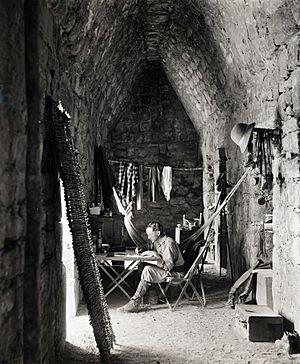Alfred Maudslay facts for kids



Alfred Percival Maudslay (born March 18, 1850 – died January 22, 1931) was a British explorer and archaeologist. He was a pioneer in carefully studying ancient Maya ruins. His detailed work helped us understand a lot about the Maya civilization.
Maudslay published his findings in a huge five-volume set called Biologia Centrali-Americana: Archaeology. This collection is still very important for people who study Maya culture today. He also translated an important book about the Spanish conquest of Mexico, which is still the main English version.
Contents
Early Life and Travels
Alfred Maudslay was born in 1850 near London into a wealthy family. His grandfather was a famous engineer named Henry Maudslay. Alfred went to Harrow School and then studied science at Trinity Hall, Cambridge.
At Cambridge, he became friends with people interested in archaeology. After college, he traveled a lot. He visited Central America, Mexico, and even Yosemite National Park in the United States. He also went to Iceland. Because of ongoing health issues, he decided not to become a doctor. He then looked for a warmer place to live.
Working for the British Government
In 1874, Maudslay went to Jamaica. He planned to start a tobacco farm, but an illness outbreak changed his plans. He met William Cairns, a British governor, who offered him a job as his personal secretary. Maudslay worked with Cairns in Trinidad and later in Australia.
He then moved to Fiji in 1875 to work with Governor Arthur Gordon. He helped with efforts to work with local tribes. Later, he served as a British consul in Tonga and Samoa.
While in the South Pacific, Maudslay became interested in collecting cultural items. He donated many of these items to Cambridge University. This helped create the University Museum of Archaeology and Ethnology. Before leaving the region, he decided to focus on archaeology. His friend, Osbert Salvin, encouraged him to explore the Maya ruins of Quiriguá and Copán.
In 1880, Maudslay left his government job after six years. He then traveled to Guatemala to begin his archaeological work.
Becoming an Archaeologist
In Guatemala, Alfred Maudslay began the important archaeological work he is known for. He started at the Maya ruins of Quirigua and Copan. He hired local workers to help clear and map the ancient structures. He was the first person to describe the site of Yaxchilán.
He also explored Chichen Itza in the 1880s with Teobert Maler. They spent weeks there, taking many photographs. Maudslay later published the first detailed description of Chichen Itza in his book, Biologia Centrali-Americana.
New Archaeology Methods
Maudslay developed many new techniques for archaeology. He hired experts to make plaster casts of the carvings he found. Other workers made casts using papier-mâché. An artist named Annie Hunter drew detailed pictures of these casts. The casts and drawings were then sent to museums in England and the United States.
Maudslay also took many detailed photographs. He used a new method called dry plate photography. He also made copies of the ancient inscriptions.
Major Discoveries and Publications
In total, Maudslay made six trips to Maya ruins. After 13 years of hard work, he published his findings in 1902. This was the five-volume book called Biologia Centrali-Americana: Archaeology. One volume explained the four volumes of photographs, maps, and drawings of Maya ruins. He even included an explanation of Maya calendar symbols by Joseph Thompson Goodman. Maudslay's careful work set a high standard for future archaeological reports.
Later, Maudslay wanted to study Monte Albán in Mexico. However, he could no longer pay for the work himself. His family's engineering business had gone bankrupt. He tried to get funding from other organizations but was not successful.
In 1905, Maudslay began translating the writings of Bernal Díaz del Castillo. Díaz del Castillo was a soldier who wrote about the Spanish conquest of Mexico. Maudslay finished this translation in 1912.
Personal Life
In 1892, Maudslay married Anne Cary Morris from the United States. For their honeymoon, they traveled to Guatemala. There, they worked for two weeks for the Peabody Museum of Archaeology and Ethnology at Harvard University. They wrote a book about their travels called A Glimpse at Guatemala.
Annie Maudslay passed away in 1926. In 1928, Maudslay married Alice Purdon. In his later years, he wrote his own life story, called Life in the Pacific Fifty Years Ago.
Alfred Maudslay died on January 22, 1931, in England. His remains were placed in the crypt of Hereford Cathedral next to his first wife. The items he collected are now kept at Harvard and the British Museum.
Selected Works
- Historia verdadera de la conquista de la Nueva España (The True History of the Conquest of New Spain) by Bernal Díaz del Castillo. London 1908 Hakluyt Society (4 Volumes, 214 chapters with Appendices) from the only original copy published by Genaro García in Mexico in 1904 with notes and appendices – considered the most complete and authentic translation Volume 1, Volumes 2,and 3, Volume 4, and Volume 5 abridged in 1928 as The Discovery and the Conquest of Mexico 1517-21
- Archaeology. 1850–1931. (followed by the Atlas edited by F. Ducane Godman and Osbert Salvin; or, Contributions to the knowledge of the fauna and flora of Mexico of Central America. (Reprint 1974)
- Biologia Centrali-Americana: Contributions to the Knowledge of the Fauna and Flora of Mexico and Central America (reprint), University of Oklahoma Press, 1983. ISBN: 978-0-8061-9919-1.
- Anne Cary Morris Maudslay and Alfred Percival Maudslay, A Glimpse at Guatemala, and Some Notes on the Ancient Monuments of Central America, London, John Murray, 1899. (Reissued by Cambridge University Press, 2010. ISBN: 978-1-108-01704-6)
- Life in the Pacific Fifty Years Ago, London: George Routledge & Sons, 1930.
See also
 In Spanish: Alfred Maudslay para niños
In Spanish: Alfred Maudslay para niños

